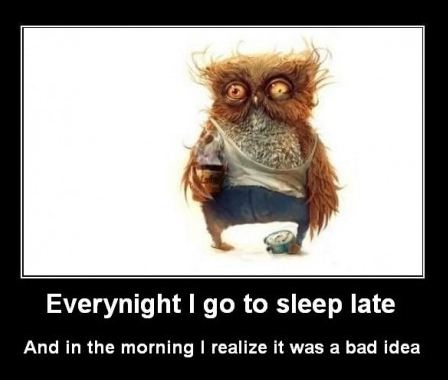

Limit exposure to light in the hour before bed, such as by staying away from screens, Drerup said. It loses that momentum that they started to develop at the end of the workweek." "They'll start to adjust as the workweek goes by, and then they stay up late and sleep in on the weekends. "This is where, a lot of times, night owls will struggle," Drerup said. Drerup recommended slowly shifting your wake-up alarm earlier by 15 to 20 minutes every few days over the course of several weeks until you're adjusted to your ideal schedule.Ĭonsistency is key. If you want to wake up earlier, make the change gradually. These activities are stimulating and reinforce the person’s tendency to stay up late.īecause the environment is a factor in determining whether a person is a night owl or a morning person, it is possible to change your sleep-wake cycle. For example, night owls feel more productive and alert at night, so they tend to exercise and socialize in the evening. People tend to participate in daily activities that reinforce their chronotype, Drerup said. "Despite all the other contributors to variation, the genetic effect still shines through," Jun Li, a geneticist at the University of Michigan who was not involved in the study, told Live Science.Environment also plays a large role. Geneticists, however, say that a large study like this could help boost researchers' confidence in the statistical significance of the genetic impact on circadian rhythms. But, changing life circumstances and exposure to light - such as sitting in front of a computer in an office late at night, or going for a hike on a vacation - can change whether someone is a morning person or a night person, according to Roenneberg. Being born with a predisposition toward waking early or sleeping in may make it more difficult for people to change their circadian rhythm. That's what allows people to recover from jet lag, or work as flight attendants and shift workers, Roenneberg said. Moreover, circadian rhythms are adaptable. Although it can be assessed by certain questionnaires, simply asking people whether they consider themselves morning or night people will not provide an objective chronotype, he added. How circadian rhythm manifests itself depends on a number of factors, such as sunlight and temperature, as well as genes, Roenneberg said. There are very, very short people, very, very tall people, and the rest are in between." "There aren't two shoe sizes and there are not just two body heights. "It is a continuous trait, as is body height or shoe size," Roenneberg told Live Science.

And people over 60 said they preferred mornings more than those under 30 (63.1 percent, compared with 24.2 percent of participants under age 30), the researchers said.īut the distinction between being a morning person or an evening person isn't quite so simple, according to Till Roenneberg, a professor at Ludwig-Maxmilian University in Munich, Germany, who studies circadian rhythm. Women were more likely to be early risers (48.4 percent, compared with 39.7 percent of men). The scientists found that having one of 15 genetic variants increased a person's chances of being a morning person by between 5 percent and 25 percent, according to the study. By comparing the survey responses with information from the participants' DNA, the scientists were able to analyze whether any single base-pair mutations - called single nucleotide polymorphisms, or SNPs - showed up more frequently in people who identified themselves as being a morning person.


 0 kommentar(er)
0 kommentar(er)
